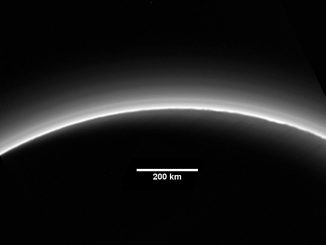
Scientists using the powerful Hubble Space Telescopes have identified three tiny objects at the frontier of the solar system that NASA’s New Horizons spacecraft could visit after making an historic flyby of Pluto next summer.
The icy worlds — each about 10 times larger than a typical comet but a fraction of Pluto’s size — reside in the Kuiper Belt, a zone of thousands of little-studied objects beyond the orbit of Neptune.
They orbit about 4 billion miles from the sun and are leftover remnants from the solar system’s formation 4.6 billion years ago.
The primary target is known as PT1, short for Potential Target 1. Two other objects have the preliminary names of PT2 and PT3.
Pluto is one of the largest Kuiper Belt Objects, or KBOs, and New Horizons will make the first close-up visit to the unexplored dwarf planet when it flies by on July 14, 2015.
With the size and shape of a grand piano, the space probe has enough propellant to fly toward another object after Pluto, but mission managers had to find a target in a narrow corridor within the New Horizons spacecraft’s fuel reach.
Scientists want to study KBOs because they are thought to be primitive relics from the ancient solar system, unaltered by warmth from the sun. Tiny objects like the three targets identified in Hubble imagery are likely the building blocks for larger worlds like Pluto.
“This has been a very challenging search and it’s great that in the end Hubble could accomplish a detection — one NASA mission helping another,” said Alan Stern, principal investigator for the New Horizons mission from the Southwest Research Institute in Boulder, Colo.
Scientists started looking for a follow-up taget for New Horizons in 2011 using ground-based telescopes, but the surveys turned up no suitable options.
Officials asked for precious observing time on Hubble this summer, using the space-based telescope’s main wide-field imaging camera to discover objects, track them over time to measure their orbits, and determine whether they were within the spacecraft’s reach.
“We started to get worried that we could not find anything suitable, even with Hubble, but in the end the space telescope came to the rescue,” said John Spencer, a New Horizons science team member from SwRI. “There was a huge sigh of relief when we found suitable KBOs; we are over the moon about this detection.”
Officials said New Horizons would likely be in position for a flyby of one of the freshly-discovered objects around 2019.
One of the three Kuiper Belt Objects — PT1 — is “definitely reachable,” according to a press release from the Johns Hopkins University Applied Physics Laboratory, which manages the New Horizons mission for NASA.
The mini-worlds are between 15 miles and 34 miles (25-55 kilometers) across, scientists said.
The other two — PT2 and PT3 — are “potentially accessible” and will require additional tracking over several months to determine whether New Horizons has enough fuel to reach them.
The spacecraft will have to adjust its trajectory some time after leaving Pluto next year to aim for another flyby of a Kuiper Belt Object.
NASA must approve scientists’ plans for a second flyby with New Horizons. The space agency has only endorsed the mission’s encounter with Pluto, and mission managers will propose an extended mission for consideration by NASA in late 2016.



